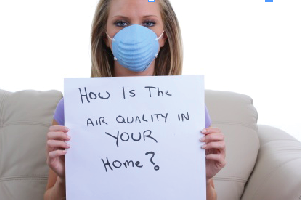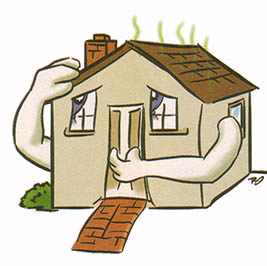Home is where the hazard is
By Shadi Nahas, PhD

Out of sight, out of mind. If it doesn’t smell bad, look bad or make you feel bad, is it harmful? The problem with air quality awareness is that air is invisible, so most of us forget it’s there and forget to question whether what we are breathing is healthy.
Canadians spend close to 90% of their time indoors; at home, at work and in recreational environments. Most people, however, are unaware of the effects that poor indoor air quality can have on their health, and most media coverage about pollution refers to the air outside.
Pollutants all pose varying degrees of potential risk. Some risks are simply unavoidable. Some we choose to accept because the alternative would restrict our ability to lead our lives the way we want. Some risks we might decide to avoid if we had the opportunity to make informed choices. The good news is that the situation is not a helpless one and all of us have the ability to control the quality of our indoor air. The first step is to identify the potential hazards. The second is to limit our exposures.
Sources of indoor air pollutants
The indoor air pollutants that affect humans are often grouped as either biological or chemical.
Biological Pollutants
Biological pollutants originate from living things or are themselves living things. Some common biological pollutants are bacteria, pollen, viruses, dust mites, animal dander, and mould.
Adverse health effects of biologics depend on the type and the amount, and on individual sensitivities. Allergic reactions are the most common health problem associated with biological pollutants. Reactions can range from mildly uncomfortable to life-threatening, as in a severe asthma attack or organ failure and cancer. Some common signs and symptoms include:
- Runny nose, sneezing and itchy watery eyes
- Coughing, wheezing and shortness of breath
- Headache and fatigue
Moulds
Moulds can grow on virtually any organic surface (wood, paper, carpet, foods and insulation) as long as moisture and oxygen are available. Mould growth often looks like a stain and comes in a variety of colours. Mould may not be visible but may have a musty odour…that ‘basement smell’ we all are accustomed to but rarely question.
In order to reproduce, moulds release small spores into the air which are inhaled by us. Spores exist outdoors, but when mould grows indoors, the concentration gets much higher. Over 250 species of mould have been identified in Canadian homes, each of which has its own impact on health. Moulds can also carry toxins, called mycotoxins, which can cause toxic or allergic damage to organs and tissues in the body, including the liver, the central nervous system, the digestive tract and the immune system.
Washing, cooking, air humidifiers, condensation and leaks from the outside all create the kind of moisture that mould needs to grow. Poor ventilation raises humidity and leads to condensation, which also allows mould to grow. Health Canada and the U.S. Environmental Protection agency consider mould to be a hazard and recommend complete removal of mould, regardless of the species.
Keeping your home dry is the only way to prevent growth. The following are basic steps to prevent and reduce mould growth:
- Keep indoor humidity under 45% in the summer and under 30% in winter
- Fix any water leaks promptly
- Properly seal tubs and sinks
- Dryer hoses and fans should be vented to the outdoors
- Clean dehumidifier filters and humidifiers regularly
- Don’t over water plants
- Clean pre-existing contamination
- Check for signs of moisture and moulds. Remember, mould can be lurking under ceiling tiles and behind walls. For a more in-depth strategy, check out the Canadian Mortgage and Housing Corporation’s guideline for cleaning and preventing mould on their website.
Dust Mites
People who are allergic to ‘dust’, are actually allergic to dust mites (and their feces). These microscopic bugs live on pillows, mattresses, bedding, stuffed toys, upholstered furniture, fabrics and carpets. They feed on skin flakes from people and thrive in humid environments. They can trigger asthma symptoms and can cause asthma in children with no previous asthma symptoms. The key to controlling the mites include:
- Wash bedding in hot water (at least 130° F)
- Encase mattresses and pillows with impermeable covers
- Avoid carpets and rugs. Vacuuming helps, but dust mites cling to carpet fibres
- Use a vacuum with a HEPA filter or a central vacuum system that vents to the outside
- Replace furnace and air filters regularly
- Dust with a damp cloth, not dry dusting
- Keep humidity levels under 50%
Animal Dander
Pets are a part of the family, but their dander can pose health problems. Dander comes from the saliva and oil glands of furry animals, such as dogs, cats, hamsters, gerbils and mice. Unfortunately, the most effective way of dealing with dander is to get rid of the pets in your home. This is not an option for many, so it may help to restrict a pet’s access to your bedroom where you spend most of your time. Also, bathe pets regularly and consider housing pets outdoors.
Outdoor Pollen
Outdoor pollens (e.g. tree, grass, ragweed) can trigger asthma in people who are allergic.
Remember:
- Pollen levels are highest in early morning, so keep windows closed at nights
- Make your house airtight to reduce pollen entry
- Air conditioners can help, but make sure your filters are mould-free
- Use a HEPA air filter in your ventilation system and replace the filter every 2 months
Chemical Pollutants
Pollutants from combustion appliances
It’s basic. We need to cook, clean and keep warm, but these acitivities produce noxious substances in our home. Gas stoves, fireplaces and furnaces all produce carbon monoxide, nitrogen dioxide and airborne particles, all of which may harm health. Eliminating these appliances is not feasible, but there are ways to protect yourself.
Carbon monoxide and nitrogen dioxide are odourless, tasteless and colourless, but can have serious health effects. At low levels symptoms include headaches, fatigue, shortness of breath, and high levels of exposure can result in chest paid, poor vision, difficult thinking and can potentially cause coma. Sources include gas stoves, water heaters, fireplaces, and furnaces. The key is ventilation. Always cook with a good-quality fumehood and make sure fireplaces and furnaces are well-ventilated. Carbon monoxide detectors throughout the home are a must.
Although wood smoke smells great on a cold winter’s night, it contains a number of toxic pollutants including: carbon monoxide, volatile organic compounds (VOCs), polycyclic aromatic hydrocarbons (PAHs) and particulate matter. Adverse affects include: eye, nose and throat irritations, as well as headaches, nausea and dizziness. Wood smoke can make asthma worse and it has been associated with an increase in respiratory problems. Limit your exposure to hazardous fumes by routinely cleaning your chimney.
Formaldehyde
It’s everywhere, and you’d be hard-pressed to go one day without exposure to it. Formaldehyde is and extremely popular chemical used to make building materials and household products and it is a byproduct of burning materials.
Sources include:
- Pressed wood products (particle board, hardwood, plywood)
- Paints, adhesives, and varnishes
- Wallpaper, cardboard and paper products
- Vehicle exhaust from attached garages
- Smoke from fireplaces and tobacco smoke.
In 1999, formaldedyde was classified as ‘toxic’ under the Canadian Environmental Protections Act. It can cause burning sensations in the eyes, nose and throat, nausea, and respiratory problems. High concentrations may trigger attacks in people with asthma and sensitivities, and has been shown to cause cancer in animals at extremely high levels. According to a study by Health Canada, formaldehyde levels in the average Canadian home are 20-40ug/m3. Current guidelines state that no visible adverse effects of formaldehyde below 50ug/m3, but this does not include allergy.
Protect yourself by not buying pressed wood products and finishes that contain fomaldehyde. Products that contain formaldehyde often do not state that fact, but products that don’t usually do because of increased consumer demand for healthier home products.
Radon
As uranium naturally breaks down, radon gas escapes from the ground and enters the home through dirt floors, cracks in concrete walls and floors, floor drains and sump pumps. Elevated radon exposure is deemed by the Canadian Lung Association to be the second leading cause of lung cancer after smoking. To know if you have radon in your home, you have to test for it. There are many companies that do this, and do-it-yourself kits are also available. The best test is a long-term test and takes about three months. Health Canada recommends radon levels of less than 200 Bq/m³. Anything above 600 Bq/m³, should be repaired within a year; between 200 Bq/m³ and 600 Bq/m³, within two years.
Asbestos
Anyone who’s had asbestos in their home knows that it’s a costly headache remove. Asbestos is a natural durable mineral used as an insulator. Asbestos is strictly regulated under the Hazardous Products Act, but many homes and buildings built before 1978 still contain it. Problems usually arise when its fibres are not properly sealed and become airborne and inhaled, thereby potentially causing asbestosis, a scarring of the lungs that leads to breathing problems and heart failure. Asbestos can only be safely inspected and removed by a professional.
Pesticides
It makes sense that if pesticides kill other living things, they may harm us as well. Even if you do not use pesticides indoors, you are unintentionally bringing pesticides inside on your shoes, clothing and pets. Besides their potential immediate toxicity, pesticides tend to linger around for years. The best way to avoid pesticides is to not use them. To block outdoor pesticides from getting in remove your shoes inside the house and don’t allow children and pets to play on grass has been sprayed with chemicals. If you have a pest problem, there is no shortage of non-toxic solutions you can use.
Second-hand Smoke
There are thousands of hazardous chemical compounds in second-hand smoke, including arsenic, ammonia, carbon monoxide and formaldehyde. Second-hand smoke is a pollutant that can be easily controlled by not allowing people to smoke indoors. If you smoke, get help and quit.
Conclusion
Ventilate and eliminate. You don’t have to suffer from poor indoor air quality. Learning more about air pollutants helps to understand how to spot them and how to limit them. If it all seems too daunting to handle alone, contact an inspector who specializes in these issues. It’s never too late to clean house.

